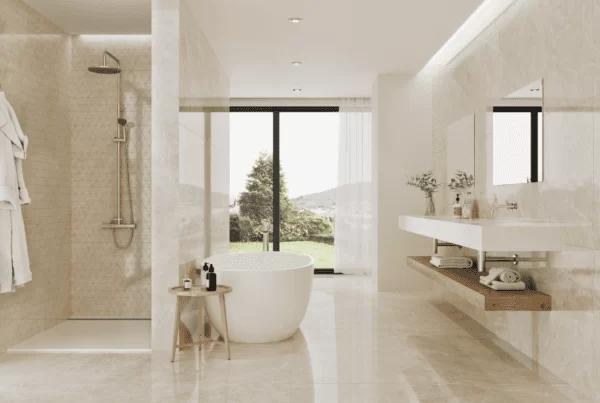Explanation of the various types of full bodied porcelain tiles
Porcelain as we know is a tile that is very popular and very commonly used amongst customers these days, and this is due to its many characteristics that make it suitable for use in a wide variety of applications, such as beautiful flooring tiles, decorative wall cladding, fancy work surfaces, stunning tables and many more functionalities! Although porcelain does originate from the family of ceramic tiles, it does differ a little from those sorts of tiles with regards to the raw materials used in making them, and in terms of the process of manufacturing the tiles as well. Consequently, porcelain tiles have been made to be more durable and stain resistant, in addition to being more cost effective relative to similar ceramic tiles, and so this is the reason behind why the usage of porcelain tiles has been on a steep incline over the past couple of decades.
Variety of porcelain
As porcelain production methods have been developing, and as more research has gone into making porcelain tiles, experts have been able to improve the efficiency of porcelain, and so nowadays, porcelain comes in a wide variety of different thicknesses, in order to be specific for each use – for example porcelain used for flooring is usually a little thicker than that used for wall cladding, in order to resist more pressure under more heat from underfloor heating, water pipes and other essential home accessories that may be installed. Furthermore, porcelain can come in many different sizes, in order to be fit for use in different sized rooms within the house, but still be the same tile of the exact same colour and pattern, in order to achieve an elegantly uniform look across the whole building. There are also porcelain tiles that are made in specific ways to be functional and optimal for many different specific functions, such as outdoor patio porcelain tiles, outdoor driveway porcelain tiles, outdoor fence cladding porcelain tiles, in order staircase porcelain tiles, indoor wet room porcelain tiles, and many more varying specifically manufactured porcelain tiles.
Glazed porcelain tiles
Porcelain tiles can also fall under different categories with regards to the glazing on the surface of the stone, such that porcelain tiles can come in either glazed or unglazed forms – which is more commonly known as full bodied porcelain – and even within the list of glazed tiles, there are variations in the type of glazing used. Previously, with ceramic tiles and early porcelain tiles around half a century ago, the full bodied stone was generally much stronger and more durable than the glazed versions of the same stone, and so they were of a better quality type of stone. However, as technology developed, and as changes to the stone mixture have incurred, this is not the case anymore, and so these days, the quality of the same sort of tiles will not differ at all, and will not depend at all on whether or not the tile is glazed. In addition, they tend to be price matched, or have a very slight dismissible difference in the price between the two, and this is very beneficial, as customers are now able to choose between the various options of porcelain purely based on their preference and the specific design, colour, texture, or finish, rather than worrying about other factors that play a role in the decision, similar to what customers of previous decades had to experience.
Full Bodied Porcelain
Unglazed (or full bodied porcelain) tiles can never be pure porcelain tiles, and that is because the pure porcelain mixture will only result in a very plain and mono coloured tile. However, the fact that manufacturers must include a design within the stone to make it look attractive and appealing, they must add various minerals, pigments, and other kinds of substances, such as zinc oxide, iron, silicic acid, haematite, and many others. The nice thing about full bodied porcelain is that the designs and colours extend all the way through the tile, and so even in the rare case that the stone is chipped a little from an edge, the chip will not be easily distinguished and will not be distinctive at all, as the colour underneath the chipped area will flow with the rest of the tile’s colour and design.
Some full bodied porcelain tiles are categorised as double loaded. These types of tiles tend to consist of relatively expensive pigments or valuable minerals and rocks such as cobalt, and the idea behind this sort of technology is that two separate layers of clay are compressed together to create a homogeneous product, so that one layer is pure clay, whilst the other layer contains the varying compound, and so there is less use of the expensive substance within the porcelain, reducing the overall cost of the tile, but achieving an equally glamorous looking porcelain tile.
One other form of double loaded full bodied porcelain tiles are encaustic tiles, which is a more traditional manner of producing reasonably priced tiles containing valuable materials, but it is a very efficient technique, such that it is still popular in use today amongst manufacturers. This procedure involves pressing the moisturised tile base onto a sturdy template with a pattern integrated within, so that the decorative design would be stamped onto the surface of the stone whilst it is being fired within the kiln. Once that is over, the small recessive sections made on the stone will be filled with liquidised substances of various colours, most commonly slip clay, and they will be left to settle, and this will create a beautiful pattern that runs across the tile.
Even though full bodied tiles are the more traditional kind of tiles compared to the glazed ones, but this type of porcelain has been developed further over the decades, and so it has become much more practical and useful than before. Therefore, we can see that these sorts of unglazed tiles are still very popular within the market these days, and they are still in function.



